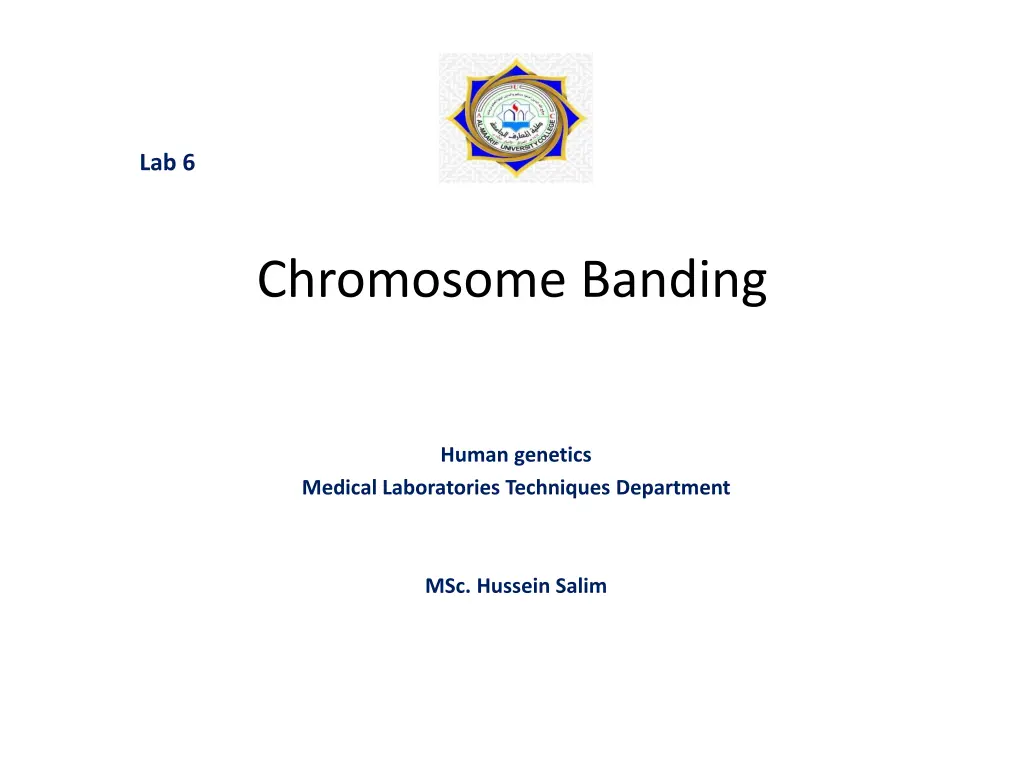
Understanding Chromosome Banding Techniques in Human Genetics
Chromosome banding refers to the alternating light and dark regions along a chromosome, aiding researchers in identifying gene locations and structural composition through staining and microscopic examination. G-banding with Giemsa staining is a common cytogenetic technique that produces detectable karyotypes, correlating dark G-bands with AT-rich DNA regions. Hydrophobic proteins in positive G-bands help maintain condensed chromosomal areas. Explore more about the significance and application of chromosome banding patterns in genetic research.
Download Presentation

Please find below an Image/Link to download the presentation.
The content on the website is provided AS IS for your information and personal use only. It may not be sold, licensed, or shared on other websites without obtaining consent from the author. If you encounter any issues during the download, it is possible that the publisher has removed the file from their server.
You are allowed to download the files provided on this website for personal or commercial use, subject to the condition that they are used lawfully. All files are the property of their respective owners.
The content on the website is provided AS IS for your information and personal use only. It may not be sold, licensed, or shared on other websites without obtaining consent from the author.
E N D
Presentation Transcript
Lab 6 Chromosome Banding Human genetics Medical Laboratories Techniques Department MSc. Hussein Salim
What is the Chromosome banding Chromosome banding refers to alternating light and dark regions along the length of a chromosome, produced after staining with a dye. A band is defined as the part of a chromosome that is clearly distinguishable from its adjacent segments by appearing darker or lighter with the use of one or more banding techniques. This process helps the researchers better understand and identify their structural composition.
Banding patterns are chromosomal patterns of bright and dark transverse bands. These bands identify where genes are located on a chromosome. The bright and dark bands are visible when the chromosome is stained with a chemical solution and examined under a microscope.
A stain can bind to the DNA through intercalation, minor groove or major groove binding, or external binding. These modes of binding depend on the type of interaction the stain have with the DNA.
Chromosome Banding Pattern G-banding or Giemsa Staining cytogenetic procedure that produces a detectable karyotype by staining compressed or condensed chromosomes. This is the most basic chromosomal banding technique. Because the whole complement of chromosomes is photographed, it can be used to detect genetic disorders. Giemsa, a visible light dye, binds DNA via intercalation. Giemsa stain is a combination of anionic eosin (like eosin Y) and cationic thiazine dyes. The cells are frozen in metaphase and then fixed, dropped, and burst after becoming turgid and bloated. Before Giemsa staining, the chromosomal spreads are processed and air-dried.
The bands (G bands) correlate approximately with the DNA sequence underlying it: AT-rich areas stain darkly, GC-rich areas lightly About 400 dark bands per haploid genome are seen in this way.
Positive G-bands The darkly stained bands are positive G-bands. These areas are hydrophobic and facilitate the precipitation of the thiazine-eosin compound. The hydrophobic proteins are responsible for hydrophobicity. These proteins maintain the condensed areas. They are primarily AT-rich regions and formed the late replicating heterochromatin (is a cytologically dense material that is typically found at centromeres and telomeres. It mostly consists of repetitive DNA sequences and non-coding RNA transcripts and is relatively gene poor, most property is silence euchromatic gene expression. Negative G-bands Negative G-bands are light-stained bands. These are less condensed early replicating euchromatin. Base pairs from GC are abundant in these areas. These areas are less hydrophobic and less conducive to the precipitation of thiazine-eosin.
C-banding Heterochromatin is recognised by the C-banding technique, which stains heterochromatin regions of centromeres. The centromere, located close to the centre of the chromosome at the attachment point of the two chromatids, plays an essential function in the DNA division during mitosis and meiosis. Condensed DNA is called heterochromatin, which is crucial for gene expression. Several plant and animal species, including humans, have had their chromosomes identified using the Giemsa-C-banding technique.
Q-banding Quinacrine, a yellow fluorescent stain, is used in the chromosomal banding technique known as Q-banding. A UV lamp is required to view the fluorescent bands after it has been stained. These bands will overlap with those that appear during G-banding. Q-banding can therefore identify similar chromosomal structural anomalies as G-banding. However, the fluorescent bands in Q-banding will disappear swiftly compared to the bands that develop in G-banding. The chromosomes must therefore be examined shortly after staining. This method is used to identify mouse and human chromosomes
R-banding The G-band staining technique is reversed by the cytogenetics process known as R-banding. R-banding is also known as Reverse chromosome banding. This banding method produces a chromosomal band pattern that is the opposite of the G-band and Q-banding patterns. The dark band (AT-rich region) seen in the G- banding method appears light in the R-banding technique and vice versa. Guanine-cytosine-rich R bands are darker in colour, and adenine-thymine-rich sections are more susceptible to heat denaturants. The method is beneficial for examining chromosomal translocations or deletions of genes involving telomeres. Giemsa stain is also used in the R-banding procedure; however, the slide is heated in a buffer solution to 88 C before Giemsa staining. DNA denaturation results from heat.
Application of Chromosome Banding Identifying chromosomal abnormalities and genetic diseases like Down syndrome depends greatly on chromosome banding. The additional 21st chromosome that results in Down syndrome can be found using chromosomal banding. Visualising the evolutionary connections between chimpanzees and humans can also be accomplished with chromosome banding. Since chimpanzees and humans share many chromosomes, chromosomal banding can be used to establish the relationship between the two species and how each has evolved.
